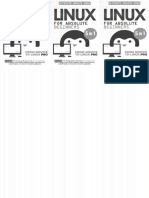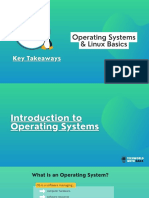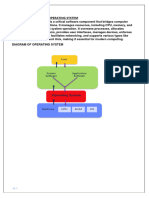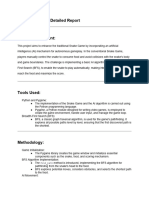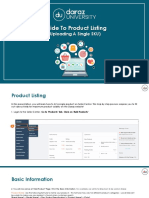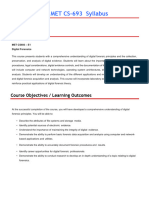LINUX
For DevOps Engineers and Cloud Engineers
Chandra Sekhar Ravella
Table of Contents:
Fundamentals of Linux
Operating System (OS):
An Operating System (OS) is system software that acts as an intermediary between
computer hardware and the user. It manages hardware resources and provides a set of
services for application software.
What Does an Operating System Do?
At a high level, an OS performs five key functions:
1. Process Management
o Manages processes in the system: creating, scheduling, and terminating.
o Ensures that multiple programs can run concurrently without interfering.
2. Memory Management
o Keeps track of each byte in a computer’s memory and manages allocation
and deallocation.
o Handles virtual memory, where programs can use more memory than
physically available.
3. File System Management
o Organizes and manages data on storage devices like hard drives or SSDs.
o Provides an interface for reading/writing files and managing directories.
4. Device Management
o Controls hardware devices via device drivers.
o Manages communication between software and peripherals like printers,
keyboards, etc.
5. User Interface
o Offers either a Command-Line Interface (CLI) or a Graphical User Interface
(GUI) to interact with the system.
Chandra Sekhar Ravella
Examples of Operating Systems:
• Windows (by Microsoft)
• macOS (by Apple)
• Linux (open source, many distributions like Ubuntu, Fedora)
• Android (based on Linux, for mobile devices)
• iOS (by Apple, for iPhones/iPads)
History of Operating Systems:
Period Focus Key OSs
1940s–50s Manual operation –
1950s–60s Batch processing GM-NAA I/O, early IBM OS
1960s–70s Time-sharing, multiprogramming Multics, CTSS
1970s Portability, UNIX UNIX, VMS, BSD
1980s Personal computing, GUIs MS-DOS, Mac OS, Windows
1990s Networking, open source Windows 95, Linux
2000s–Today Mobile, cloud, virtualization Android, iOS, Linux
Why Linux Over Windows?
1. Cost-Effectiveness
• Free and Open Source: Linux does not require expensive licensing fees,
making it a cost-effective choice for companies.
• Lower Maintenance Costs: Linux is stable and requires minimal
maintenance, reducing operational expenses.
Chandra Sekhar Ravella
2. Performance and Efficiency
• Better Resource Utilization: Linux is lightweight and consumes fewer
system resources compared to Windows.
• High Scalability: Linux efficiently scales from small embedded systems to
enterprise data centers without performance degradation.
3. Security and Reliability
• Less Vulnerable to Malware: Linux has strong user privilege separation,
making it more secure against viruses and malware.
• Frequent and Transparent Updates: Regular security patches ensure
system stability without requiring frequent reboots.
• High Stability: Linux systems can run for years without crashes, ensuring
better uptime and reliability.
🐧 Core Components of a Linux Machine:
(a) Hardware Layer
The physical components of the computer (CPU, RAM, disk, network interfaces, etc.).
The OS interacts with hardware using device drivers.
Chandra Sekhar Ravella
(b) Kernel (Core of Linux OS)
The Linux Kernel is responsible for directly managing system resources, including:
Process Management – Schedules processes and handles multitasking.
Memory Management – Allocates and deallocates RAM efficiently.
Device Drivers – Acts as an interface between software and hardware.
File System Management – Manages how data is stored and retrieved.
Network Management – Handles communication between systems.
(c) System Call Interface
A bridge between user space and kernel space.
Allow user programs to request services from the kernel (like reading a file or
starting a process).
Examples: open (), read (), fork (), exec ()
(d) Shell (Command Line Interface - CLI)
A command interpreter that allows users to interact with the kernel.
Examples: Bash, Zsh, Fish, Dash, Ksh.
Converts user commands into system calls for the kernel.
(e) User Applications
End-user programs like web browsers, text editors, DevOps tools, etc.
Applications interact with the OS using system calls via the shell or GUI.
Fun Fact:
Everything in Linux is treated as a file — including hardware devices!
Chandra Sekhar Ravella
🐧 Linux Distributions
A Linux distribution (often called a distro) is a complete operating system built using
the Linux kernel along with:
• System software
• User interface (GUI or CLI)
• Package Manager
• Pre-installed tools and applications
Each distro is tailored for different users — beginners, developers, security experts,
or servers.
Here are some popular Linux distributions:
Ubuntu – One of the most beginner-friendly distros, widely used for personal and server
use. It has great community support.
CentOS (discontinued, replaced by AlmaLinux/Rocky Linux) – Previously a popular
choice for servers, based on Red Hat Enterprise Linux (RHEL).
Debian – A very stable and reliable distro, often used as a base for other distros like
Ubuntu.
Fedora – A cutting-edge distro that introduces new features before they reach RHEL.
Arch Linux – A lightweight, rolling-release distro for advanced users who like
customization.
Kali Linux – Designed for cybersecurity and penetration testing.
Alpine Linux – A lightweight, security-focused distro often used in containers.
Setting Up a Linux Environment on Windows and macOS:
There are multiple ways to setup a Linux environment on a Windows or Mac
machines such as cloud vm, wsl2, virtualbox, Hyperkit e.t.c., However, what I would
recommend is using a container as a Linux environment.
Just install Docker desktop, run the below command and create Linux
container of any distribution without worrying about the cost and connectivity
issues.
Chandra Sekhar Ravella
Docker Command to Run Ubuntu Linux Container (Persistent & Long-Term)
Explanation of Each Parameter:
Chandra Sekhar Ravella
Package Managers in Linux
What is a Package Manager?
A package manager is a tool that automates the process of installing, updating,
configuring, and removing software in a Linux system. It ensures that software and its
dependencies are managed efficiently.
How Does a Package Manager Work?
1. Repositories (Repos):
o A package manager fetches software from official repositories (online storage
of packages).
o Example: Ubuntu gets packages from archive.ubuntu.com.
2. Installing Software:
o When you install the software, the package manager:
Downloads the package from the repository.
Resolves dependencies (installs additional required software).
Installs and configures the software automatically.
3. Updating Software:
o A single command updates all installed packages to the latest version.
4. Removing Software:
o The package manager also removes software cleanly without leaving
unnecessary files.
Popular Package Managers in Linux
Chandra Sekhar Ravella
How Package Managers Fetch Software from Repositories
A repository is a server that stores software packages. When a package manager
installs software:
1. It checks the repository list (e.g., /etc/apt/sources.list in Ubuntu).
2. It downloads the package and its dependences.
3. It installs and configures the software automatically.
Example of an Ubuntu Repository Entry
Types: deb
URIs: http://ports.ubuntu.com/ubuntu-ports/
Suites: noble noble-updates noble-backports noble-security
Components: main universe restricted multiverse
Signed-By: /usr/share/keyrings/ubuntu-archive-keyring.gpg
Why Should You Run apt update After Installing Ubuntu?
When you install Ubuntu, the packages included in the ISO image might be
outdated. Running:
Updates the package list from repositories.
Then, to install the latest versions of packages, run:
🛠 Essential Package Manager Commands
APT (Debian, Ubuntu)
Chandra Sekhar Ravella
DNF (Fedora, RHEL, CentOS)
Pacman (Arch Linux)
Zypper (OpenSUSE)
Best Practices for Using Package Managers:
Always update your package list before installing software:
Use autoremove to clean up unused dependencies:
Enable automatic security updates (Ubuntu):
Chandra Sekhar Ravella
📁 Linux Directory Structure
In Linux, everything is organized in a tree-like hierarchy, starting from the root
directory /.
Each folder has a specific purpose, and understanding this structure helps you navigate,
troubleshoot, and manage the system effectively.
Symbolic Links (Less Significant):
Directory Linked To Description
System binaries for administrative commands (e.g.,
/sbin /usr/sbin
reboot, shutdown, ifconfig)
/bin /usr/bin Essential user binaries (e.g., ls, cp, mv, bash)
/lib /usr/lib Shared libraries and kernel modules
Important System Directories:
Directory Description
/boot Stores files needed to boot the system (e.g., kernel, GRUB configs)
/usr Contains most user-installed applications and libraries
/var Stores logs, caches, and frequently changing data
/etc Contains system configuration files
Chandra Sekhar Ravella
User & Application-Specific Directories:
Directory Description
/home Default location for user home directories (e.g., /home/chandu)
/opt Used for installing optional or third-party software
Holds data for system services like web servers (rarely used in
/srv
containers)
/root Home directory for the root (superuser)
Temporary & Volatile Directories:
Directory Description
/tmp Temporary files; (cleared on reboot)
/run Stores runtime process information (e.g., PID files, sockets)
/proc Virtual filesystem for process/system info (e.g., /proc/cpuinfo)
/sys Virtual filesystem with hardware/kernel info (e.g., /sys/class/)
/dev Contains device files (e.g., /dev/null, /dev/sda).
Mount Points:
Directory Description
/mnt Temporary mount point for external filesystems
/media Mount point for removable devices like USBs and CDs
/data Custom mount point (commonly used in WSL for Windows volumes like C:)
Chandra Sekhar Ravella
User Management in Linux
Linux is a multi-user operating system, meaning multiple users can use the system
at the same time or at different times. User management ensures each user has the right
permissions, resources, and isolation.
Types of Users in Linux:
User Type Description
The superuser with full system access. Username: root. Can execute all
Root User
commands.
Normal
Created by the administrator or during OS installation. Limited permissions.
Users
System Created by the system for services (e.g., www-data, mysql). Typically, don’t
Users log in.
Important Files for User Management:
File Purpose
/etc/passwd Stores user account info (username, UID, home directory, shell)
/etc/shadow Stores encrypted passwords and password aging info
/etc/group Contains group information
/etc/sudoers Configures who can use sudo and how
Note: Use visudo to edit /etc/sudoers safely.
Creating Users in Linux:
To create a new user in Linux, use:
• useradd Command (For most Linux distributions)
Note: This creates a user without a home directory.
Chandra Sekhar Ravella
• To create a user with a home directory:
• To specify a shell:
• adduser Command (For Debian-based systems):
This is an interactive command that asks for a password and additional
details.
Set or Change User Password:
To set or change a user’s password:
Enforcing Password Policies:
• Password expiration: Set password expiry days
• Lock a user account
• Unlocking a user account
Modify a User:
Modify an existing user with usermod:
• Change the username:
• Change the home directory:
• Change the default shell:
Chandra Sekhar Ravella
Delete a User:
• To remove a user but keep their home directory:
• To remove a user and their home directory:
Group Management:
Groups help assign shared permissions.
• Create a Group:
• Add User to Group:
• View Groups of a User:
• Changing Primary Group:
Sudo Access and Privilege Escalation:
Adding a User to Sudo Group:
• On Debian-based systems:
• On RHEL-based systems:
Chandra Sekhar Ravella
Granting Specific Commands with Sudo:
Edit the sudoers file:
Then add:
📁 File Management in Linux
Linux treats everything as a file, including text files, directories, devices, and even
hardware!
Learning file management is essential for navigating, creating, editing, and
organizing files and directories in a Linux environment.
Basic File Terminology:
Term Description
File A collection of data (e.g., text, images, scripts).
Directory A folder that contains files or other directories.
Path Location of a file or directory. Can be absolute or relative.
File & Directory Navigation:
Command Description
pwd Show current working directory
ls List of all files and directories
cd Change directory
cd .. Go one level up
cd / Go to the root directory
cd ~ Go to home directory
Chandra Sekhar Ravella
File and Directory Operations:
Create:
Rename / Move:
Delete:
Copy:
Chandra Sekhar Ravella
View File Contents and Editing:
Command Description
cat file.txt Displays file content.
tac file.txt Displays file content in reverse order.
head -n 10 file.txt Displays the first 10 lines of a file.
tail -n 10 file.txt Displays the last 10 lines of a file.
less file.txt Opens a file for viewing with scrolling support.
more file.txt Like less but only moves forward.
nano file.txt Opens a simple text editor.
vi file.txt Opens a powerful text editor.
echo 'Hello' > file.txt Writes text to a file, overwriting existing content.
echo 'Hello' >> file.txt Appends text to a file without overwriting.
✍️ VI Editor Shortcuts in Linux
The vi editor (or its improved version vim) is a powerful text editor in Linux,
commonly used to edit configuration files and scripts directly from the terminal.
It works in three modes:
Mode Description
Normal mode Default mode when vi starts — used for navigation and commands
Insert mode Used for typing/editing text
Command mode Used for saving, quitting, searching, etc.
Chandra Sekhar Ravella
Launching VI:
• Open the file in normal mode.
• If the file doesn’t exist, it will be created upon saving.
Mode Switching:
Key Action
i Enter insert mode before the cursor
I Enter insert mode at the beginning of the line
a Enter insert mode after the cursor
A Enter insert mode at the end of the line
o Open a new line below
O Open a new line above
Esc Exit insert mode and return to normal mode
Chandra Sekhar Ravella
Basic Command Mode Shortcuts (: commands)
Command Action
:w Save (write) file
:q Quit
: wq or ZZ Save and quit
: q! Quit without saving
:x Save and exit (same as: wq)
: e filename Open another file in vi
: set nu Show line numbers
: set nonu Hide line numbers
Text Editing in Normal Mode:
Command Action
yy or Y Copy (yank) current line
p Paste after the cursor
P Paste before the cursor
dd Delete (cut) current line
x Delete character under cursor
u Undo last change
Ctrl + r Redo
r Replace a single character
R Overwrite mode (until Esc)
Chandra Sekhar Ravella
Navigation Shortcuts:
Key Action
h Move left
l Move right
j Move down
k Move up
0 Move to the beginning of line
^ First non-blank of line
$ End of line
w Jump forward one word
b Jump back one word
G Go to the end of file
gg Go to the beginning of file
: n Go to line number n
Search and Replace:
Command Action
/text Search forward for "text"
?text Search backward for "text"
n Repeat last search
:%s/old/new/g Replace all "old" with "new" in entire file
:s/old/new/g Replace in current line
Chandra Sekhar Ravella
🔐 SSH (Secure Shell)
What is SSH?
SSH stands for Secure Shell. It's a protocol used to securely connect to a
remote computer over a network — typically used to access servers, Linux systems,
and cloud instances.
Think of SSH as a secure way to control another computer using the terminal
just like you're sitting in front of it!
Why is SSH Important?
• Encrypted Communication – All data sent between you and the server is
encrypted (safe from eavesdropping).
• Remote Access – Control remote systems from anywhere.
• File Transfer – Send and receive files securely via SCP/SFTP.
• Automation – Useful for running scripts, updates, and deployment tasks on
servers.
How SSH Works
SSH uses key-based or password-based authentication.
1. You run an SSH command.
2. SSH connects to the remote machine's SSH server (usually on port
22).
3. You log in using a username + password or SSH key.
4. Once connected, you can run commands, manage files, or even
tunnel other connections securely.
Basic SSH Command:
Example:
Chandra Sekhar Ravella
• ubuntu: username on the remote machine.
• 192.168.1.10: IP address or domain name of the remote machine.
Common SSH Use Cases:
📦 SCP (Secure Copy Protocol) in Linux
What is SCP?
SCP stands for Secure Copy Protocol. It is a command-line tool used to
copy files or directories between two systems over SSH.
• It encrypts files during transfer (unlike cp or ftp).
• Works locally → remote, remote → local, or even remote → remote.
Basic Syntax:
• source: file or folder you want to copy.
• destination: where you want to copy it (can be local or remote).
• Both can be in the format: user@host:/path.
Common Use Case:
Chandra Sekhar Ravella
Useful Options:
Option Description
-r Recursively copy entire directories
-P Specify port number if not using default (22)
-i Use a specific identity file (SSH key)
-C Enable compression during transfer
-v Verbose output (helpful for debugging)
🔐 File Permissions Management in Linux
Introduction to File Permissions:
Linux file permissions determine who can read, write, or execute files and
directories. Each file and directory have three levels of permission:
👥 Types of Users:
• Owner (User): The creator of the file.
• Group: Users belonging to the assigned group.
• Others: All other users on the system.
Permissions are represented as:
• Read (r or 4) – View file contents.
• Write (w or 2) – Modify file contents.
Chandra Sekhar Ravella
• Execute (x or 1) – Run scripts or programs.
Viewing File Permissions:
Example Output:
Breakdown:
• - = regular file (d = directory)
• rwx = Owner can read, write, execute
• r-x = Group can read, execute
• r-- = Others can only read
Changing Permissions with chmod:
Using Symbolic Mode
Modify permissions using symbols:
• Add (+), remove (-), or set (=) permissions.
Examples:
Using Numeric (Octal) Mode
Each permission has a value:
• Read (4), Write (2), Execute (1).
Examples:
Chandra Sekhar Ravella
Changing Ownership with chown:
Modify file owner and group:
Recursively change ownership:
Changing Group Ownership with chgrp:
Special Permission Bits (Advanced):
SetUID (s on user execute bit):
Allows users to run a file with the file owner's permission.
Example: /usr/bin/passwd allows users to change their passwords.
SetGID (s on group execute bit):
Files: Users run the file with the group's permissions.
Directories: Files created inside inherit the group.
Sticky Bit (t on others execute bit): Used directories to allow only the owner
to delete their files.
Example: /tmp directory.
Chandra Sekhar Ravella
Default Permissions: umask
umask defines default permissions for new files and directories.
Check current umask:
Set a new umask:
⚙️ Process Management in Linux
What is a Process?
A process is a running instance of a program. Every time you execute a
command; Linux creates a process to handle it.
Each process has:
• PID (Process ID) – Unique identifier
• PPID (Parent Process ID) – ID of the parent process
• UID (User ID) – Who owns the process
• Resource info – CPU, memory usage, etc.
Index of Commands Covered:
Viewing Processes:
Chandra Sekhar Ravella
Managing Processes:
Background & Foreground Processes:
Monitoring System Processes:
Priority Value Meaning
-20 Highest priority
0 Default priority
+19 Lowest priority
Note: Only the root user can set negative nice values.
Chandra Sekhar Ravella
Daemon Process Management:
📊 Linux System Monitoring
System Monitoring in Linux is about keeping an eye on the system's health —
such as CPU usage, memory, disk, network, and running processes — to
troubleshoot issues or optimize performance.
Why Monitor a Linux System?
• Detect high CPU or memory usage
• Identify misbehaving processes
• Monitor system uptime and load
• Ensure system is stable, secure, and performant
• Perform resource planning for scaling
Index of Commands Covered:
CPU and Memory Monitoring:
top – Real-Time System Monitoring
• Shows a live view of processes and system resource usage (CPU,
memory, etc.)
• Press q to quit, k to kill a process, P to sort by CPU usage.
htop – Interactive Process Viewer (Requires Installation)
• A colorful, user-friendly alternative to top.
Chandra Sekhar Ravella
• Allows scrolling, sorting, and killing processes with keyboard
shortcuts.
• To install:
vmstat – System Performance Statistics:
• Reports on memory, processes, CPU, I/O, and more.
• 1 5 = run every 1 second, 5 times.
free -m – Memory Usage in MB:
• Shows total, used, and free memory (RAM and swap) in megabytes.
free -h – Human-Readable Memory Usage:
• Same as free -m but output is easier to read (e.g., 2.3G, 512M).
💾 Disk Monitoring:
df -h – Disk Space Usage:
• Displays total and available disk space for mounted file systems.
• -h = human-readable sizes (e.g., GB/MB).
Chandra Sekhar Ravella
du -sh * – Directory Size Usage:
• Shows size of each item (file/folder) in the current directory.
• -s: summary; -h: human-readable
iostat – CPU and Disk I/O Statistics:
• Displays CPU load and disk input/output stats.
• May require:
Network Monitoring:
ifconfig – Show Network Interfaces (Deprecated):
• Shows IP addresses and interface status.
• Now deprecated in favor of ip a.
ip a – Show Network Interface Details:
• Modern replacement for ifconfig.
• Shows interface names, IP addresses, MAC addresses, and more.
netstat -tulnp – Active Connections & Ports:
Chandra Sekhar Ravella
• -t: TCP
• -u: UDP
• -l: Listening ports
• -n: Show numeric addresses
• -p: Show process IDs and names
Note: netstat may need to be installed with net-tools.
ss -tulnp – Faster Alternative to netstat:
• Performs the same job as Netstat but faster and with more
options.
• Pre-installed on most modern distros.
ping hostname – Test Network Connectivity
• Send ICMP packets to test if the host is reachable.
• Use Ctrl+C to stop.
traceroute hostname – Trace Network Path
• Shows each hop between your system and the target server.
• It is useful to diagnose where network delays occur.
If not installed:
Chandra Sekhar Ravella
nslookup domain – DNS Lookup Info:
• Shows IP address of a domain and DNS server response.
• Good for testing DNS resolution issues.
Log Monitoring:
tail -f /var/log/syslog – Live Log Monitoring:
• Continuously shows new lines added to the system log.
• Use CTRL + C to stop.
journalctl -f – Live Logs for Systemd Systems:
• Monitors system logs in real-time.
• Works only on systemd-based systems like Ubuntu, Fedora, etc.
dmesg | tail – View Kernel Logs:
• Displays the latest kernel messages (hardware, boot info, driver
messages).
• Useful for checking hardware-related errors.
Chandra Sekhar Ravella
🌐 Networking in Linux
Linux provides a powerful set of tools and commands to manage, monitor, and
troubleshoot network configurations and connectivity.
Key Concepts:
Concept Description
IP Address Unique identifier for a device on a network
MAC Address Hardware address of the network interface
Interface Network device (e.g., eth0, wlan0, lo)
Hostname Name of the Linux system on the network
DNS Resolves domain names to IP addresses
Networking Commands:
1. ping google.com – Checks connectivity to a remote server.
2. ifconfig – Displays network interfaces (deprecated, use ip).
3. ip a – Shows IP addresses of network interfaces.
4. netstat -tulnp – Displays open network connections.
5. curl https://example.com – Fetches a webpage's content.
6. wget https://example.com/file.zip – Downloads a file from the internet.
Chandra Sekhar Ravella
💽 Disk and Storage Management in Linux
Introduction to Disk and Storage Management:
Disk management in Linux involves monitoring, formatting, partitioning, and
mounting storage devices. It helps you understand how disk space is allocated and
used, and how to manage additional drives or volumes.
Common Disk Management Tasks:
Task Description
View disk usage Check how much space is used and available
Partition disks Divide a disk into logical sections
Format disks Prepare partitions with a file system
Mount/unmount Attach/detach disks to the system
Monitor I/O Analyze disk read/write activity
Disk Usage Monitoring Commands:
df – Disk Free Space:
• Shows how much disk space is used and available on mounted
filesystems.
• -h = human-readable (e.g., GB/MB)
du – Disk Usage per Directory:
• Shows the size of a directory and its contents.
• -s: summary, -h: human-readable
lsblk – List Block Devices:
Chandra Sekhar Ravella
• Lists all attached block devices (like disks and partitions).
• Does not show mount points by default unless -f is used.
blkid – Show UUIDs and File System Types:
• Displays information about devices, UUIDs, and file system types.
mount / umount – Mount or Unmount File Systems:
• mount: attaches a device to the system
• umount: detaches the device safely
fdisk – Partition a Disk (Interactive):
• Used to create, delete, or modify partitions on MBR disks.
mkfs – Create File System:
• Formats a partition with the ext4 file system (or other: xfs, ntfs, etc.)
parted – Advanced Partitioning Tool:
Chandra Sekhar Ravella
• Useful for managing large drives, GPT, resizing, scripting.
df -T – Check File System Type:
• Shows the type of file system used on mounted partitions (e.g., ext4,
xfs, etc.)
Logical Volume Management (LVM)
• pvcreate /dev/sdX – Create a physical volume
• vgcreate vg_name /dev/sdX – Create a volume group
• lvcreate -L 10G -n lv_name vg_name – Create a logical volume
• mkfs.ext4 /dev/vg_name/lv_name – Format an LVM partition
• mount /dev/vg_name/lv_name /mnt – Mount an LVM partition
Swap Management
• mkswap /dev/sdX – Create a swap partition
• swapon /dev/sdX – Enable swap space
• swapoff /dev/sdX – Disable swap space
Chandra Sekhar Ravella







